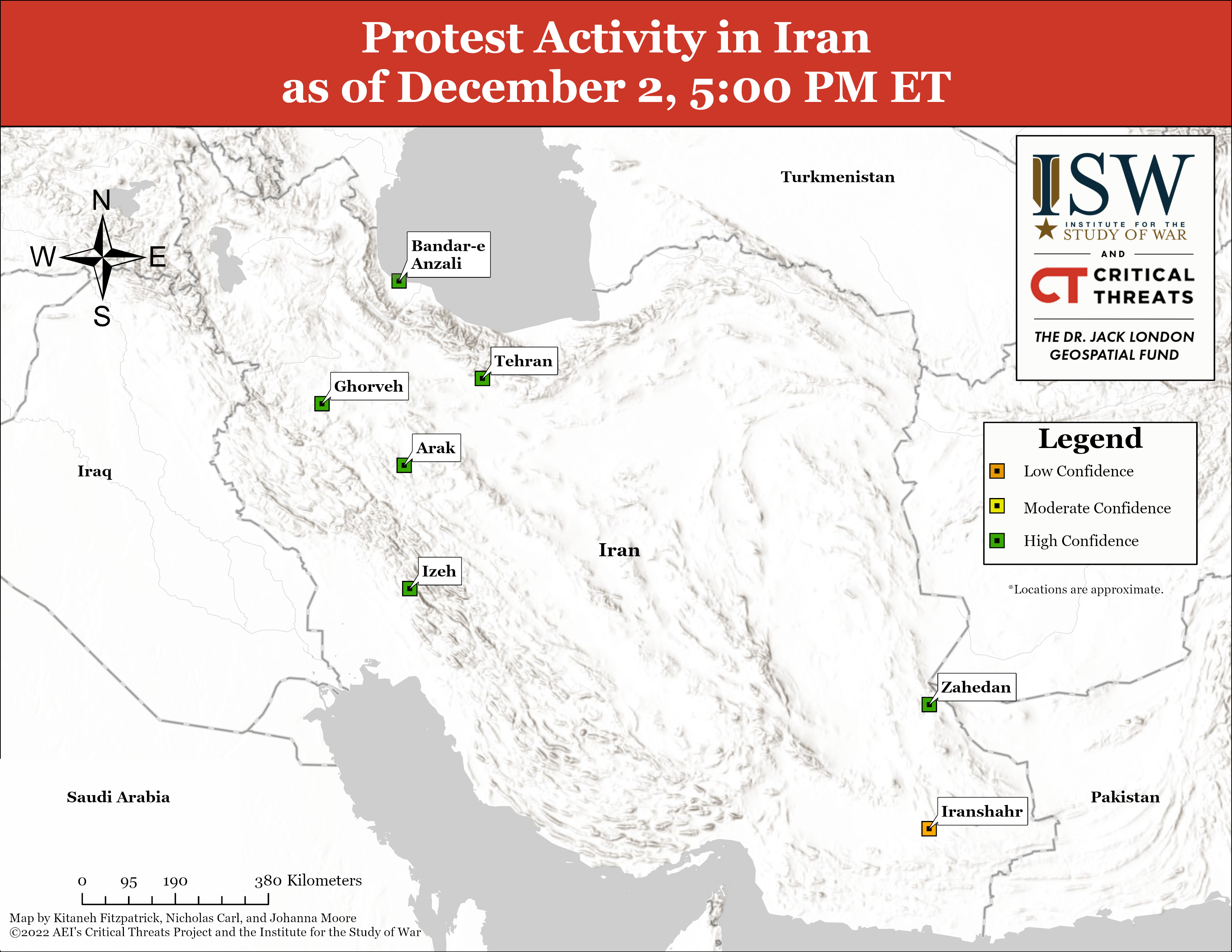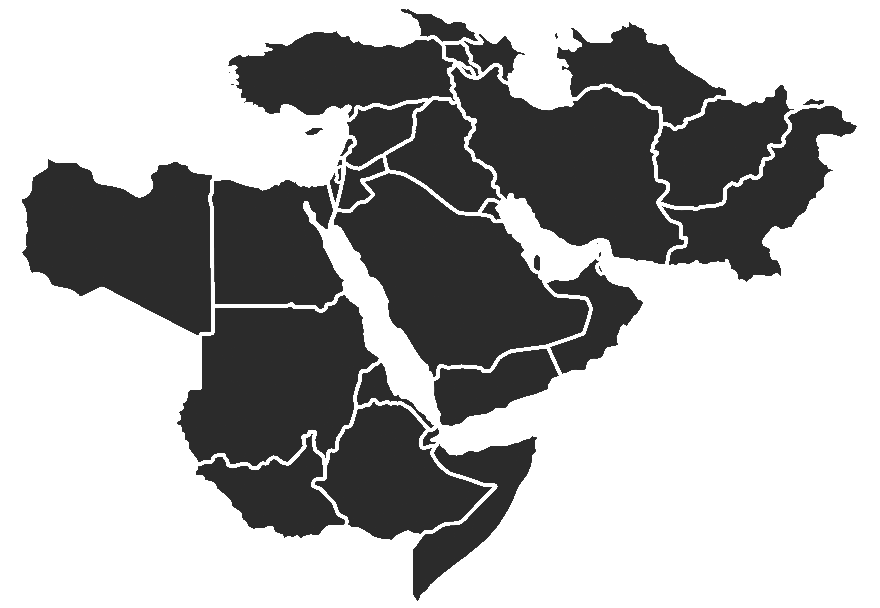{{currentView.title}}
December 02, 2022
Iran Crisis Update, December 2
December 2, 5:00 pm ET
The Iran Crisis Updates are produced by the Critical Threats Project (CTP) at the American Enterprise Institute with support from the Institute for the Study of War (ISW). To receive Iran Crisis Updates via email, please subscribe here.
Contributor: Amin Soltani
The Mashhad Neighborhood Youth issued further instructions for the planned protests on December 5-7. The Mashhad group called for street protests on December 5, protests moving toward and occupying government buildings on December 6, and countrywide protests and marches in solidarity with university students on December 7.[i] These instructions partially mirror those distributed by the Tehran Neighborhood Youth, which similarly differentiated planned protest activities by day, as CTP previously reported.[ii]
The Mashhad group provided additional guidance on how to degrade the regime’s capability to crack down on protests on December 2. The group called on protesters to target security forces on motorcycles, noting the importance of motorcycle units to the regime protest crackdown.[iii] Some of the most elite regime security units, such as the Basij Imam Ali battalions, use motorcycles to disperse and intimidate crowds and rapidly traverse busy city streets.[iv] The regime formed some of these units after the Green Movement in 2009, specifically to improve its effectiveness in suppressing protests in dense urban areas.[v] The Mashhad group previously called on its ”operational teams” to destroy CCTV cameras to prevent the state security services from using them to identify protesters on December 1.[vi]
The behavior of the Mashhad Neighborhood Youth suggests that it may be more coordinated and organized than some other youth groups in the protest movement. The Mashhad group has repeatedly issued guidance and instructions to its operational teams since November 2022, as CTP previously reported, in addition to advising protesters.[vii] The Mashhad group was also the first and second signatory of the joint youth group statements issued on November 22 and 27, respectively, suggesting that the group may have played a role in organizing the statements among the youth groups.[viii]
Anti-regime outlet Iran International published an article on December 2 suggesting that the regime is struggling to sustain the necessary equipment and manpower to continue its protest crackdown.[ix] The article reported that the regime has sought advisors and the purchase of protest suppression equipment from Russia to support the crackdown. Senior US officials warned on October 26 that Russia may advise the regime protest crackdown.[x] The Iran International article separately reported that an unidentified senior IRGC officer claimed that the IRGC tried to mobilize 1,000 retired personnel for the crackdown to mitigate manpower shortages, but that only 300 retirees were willing to help. Iran International previously reported on October 14 that the IRGC called on retirees to report to the Mohammad Rasoul Ollah headquarters—the IRGC unit responsible for security in Tehran Province.[xi] CTP cannot verify any of the reports from Iran International.
Key Takeaways
- The Mashhad Neighborhood Youth issued further instructions for the planned protests on December 5-7.
- The behavior of the Mashhad Neighborhood Youth suggests that it may be more coordinated and organized than some other youth groups in the protest movement.
- Anti-regime outlet Iran International published an article suggesting that the regime is struggling to shore up the necessary equipment and manpower to continue its protest crackdown.
- At least seven protests took place in seven cities across six provinces on December 2.
- Unidentified individuals attacked Deputy Industry, Mining, and Trade Minister for General Industries Mohammad Mehdi Baradaran on his way home.
- Prominent Sunni Cleric Moulana Abdol Hamid condemned the regime’s protest suppression response in his Friday prayer sermon in Zahedan, Sistan and Baluchistan Province.
- Prosecutor General Mohammad Javad Montazeri stated that Parliament and the Supreme Cultural Revolution Council will announce an opinion on the mandatory hijab law by December 17.
Anti-Regime Protests
At least seven protests took place in seven cities across six provinces on December 2. CTP assesses with moderate to high confidence that protests occurred in the following locations:
Bandar-e Anzali, Gilan Province[xii]
Size: Medium
Demographic: Mourners
Notes: Funeral for Mehran Samak
Ghorveh, Kurdistan Province[xiii]
Size: Small
Izeh, Khuzestan Province[xiv]
Size: Small to medium
Demographic: Mourners
Notes: Funeral for Hamed Selahshour who security forces reportedly tortured to death for participating in anti-regime protests.
Arak, Markazi Province[xv]
Size: Small to medium
Demographic: Mourners
Notes: 40-day commemoration ceremony for Sina Malayaeri
Regime Repression: Security forces verbally threaten mourners
Zahedan, Sistan and Baluchistan Province[xvi]
Size: Medium
Protester Activity: Burned ties in road
Regime Repression: Security forces fired live ammunition and tear gas
Notes: Protests followed Abdol Hamid’s Friday prayer sermon
Tehran City, Tehran Province[xvii]
Size: Undetermined
Protester Activity: Fire lit in street
CTP assesses with low confidence that protests occurred in the following locations:
Iranshahr, Sistan and Baluchistan Province[xviii]
Size: Small
Note: CTP defines small protests as fewer than 100 individuals, medium protests as between 100 and 1,000, and large protests as over one thousand.

Unidentified individuals attacked Deputy Industry, Mining, and Trade Minister for General Industries Mohammad Mehdi Baradaran on his way home, according to Iranian media on December 1.[xix] It is unclear where Baradaran lives, though he presumably has a home in Tehran given his position. Baradaran was hospitalized in critical condition after the attack.
The Shiraz Neighborhood Youth on December 2 called on protesters to send in images and videos of businesses open during the planned protests on December 5-7.[xx] The Shiraz group expressed intent to use these images and videos to organize boycotts against those businesses.
Prominent Sunni Cleric Moulana Abdol Hamid condemned the regime’s protest suppression response in his Friday prayer sermon in Zahedan, Sistan and Baluchistan Province on December 2. Abdol Hamid criticized Iranian officials for issuing death sentences to several protesters. Abdol Hamid additionally responded to the hacktivist Black Reward group’s leaked documents allegedly discussing regime efforts to undermine Abdol Hamid, stating: “If you are able to govern and have power, it is by God’s will. If we have the respect and love of the people, it is by God’s will. God bestows honor and takes it away. No one but God can take honor away.” Abdol Hamid stressed the importance of religious unity in a possible attempt to appeal to marginalized groups beyond Sistan and Baluchistan Province.[xxi] Abdol Hamid’s message is seemingly resonating with a growing number of Iranians--especially in the Iranian Sunni community—as CTP has previously reported.[xxii]
Prosecutor General Mohammad Javad Montazeri stated on December 1 that Parliament and the Supreme Cultural Revolution Council will announce an opinion on the mandatory hijab law by December 16.[xxiii]
Axis of Resistance and Regional Developments
The Washington Institute for Near East Policy published analysis on how Iranian-backed factions believe they can control major decisions in the Iraqi central government under Prime Minister Mohammad Shia al Sudani.[xxiv] Qais Khazali—the leader of Iranian proxy Asaib Ahl al Haq—stated that Sudani must refer to the Shia Coordination Framework on “strategic decisions, whether political, economic, or security,” according to the analysis. The Shia Coordination Framework is the umbrella organization for Iran-backed political factions in Iraq.
[i] https://twitter.com/Javanan_mashhad/status/1598367357008748545?s=20&t=zlaXNUNCVLApXqPObYMDuQ
[ii] https://www.criticalthreats.org/analysis/iran-crisis-update-november-30
[iii] https://t.me/mashhad_protests/1171
[iv] https://www.criticalthreats.org/wp-content/uploads/2021/12/Whatever-it-takes-to-end-it.pdf
[v] Read Saeid Golkar, Captive Society: The Basij Militia and Social Control in Iran (Washington, DC: Woodrow Wilson Center Press and New York: Columbia University Press, 2015) for a detailed analysis of the history and structure of the Basij Organization.
[vi] https://www.criticalthreats.org/analysis/iran-crisis-update-december-1
[vii] https://www.criticalthreats.org/analysis/iran-crisis-update-december-1
[viii] https://twitter.com/javanane_k/status/1595095807480717313; https://twitter.com/javanane_k/status/1596829675376070656
[ix] https://www.iranintl.com/202212022167
[x] https://www.criticalthreats.org/analysis/iran-crisis-update-october-26
[xi] https://www.criticalthreats.org/analysis/iran-crisis-update-october-14#_edn28dcd9a75f58c737721d1f4b26f531a9b0f9170428c5711aa796a758be63df961
[xii] https://twitter.com/pouriazeraati/status/1598668338083041281?s=20&t=mBI2gJvDWEcSX2-XQevjug ; https://twitter.com/1500tasvir/status/1598679126369525761?s=20&t=tqw1CQIvlZqAd2ces9XfyA
[xiii] https://twitter.com/RadioFarda_/status/1598745201488584705?s=20&t=daq-KArVZsVn2Bmnd5X1Ng ; https://twitter.com/FattahiFarzad/status/1598753291457789952?s=20&t=daq-KArVZsVn2Bmnd5X1Ng ; https://twitter.com/iranworkers/status/1598774161643835392?s=20&t=DhonAlnO-0RnZyRe-m-FAw ; https://twitter.com/FattahiFarzad/status/1598752840763158528?s=20&t=daq-KArVZsVn2Bmnd5X1Ng
[xiv] https://twitter.com/1500tasvir/status/1598721899013763075?s=20&t=1NVEsDktLVotj0G2keM3sQ ; https://twitter.com/IranIntl/status/1598723328646283265?s=20&t=1NVEsDktLVotj0G2keM3sQ ; https://twitter.com/mamlekate/status/1598765965012934656?s=20&t=1NVEsDktLVotj0G2keM3sQ ; https://twitter.com/gh0lch0magh/status/1598129152552337409?s=20&t=zlaXNUNCVLApXqPObYMDuQ
[xv] https://twitter.com/1500tasvir/status/1598656763628331011 ; https://twitter.com/1500tasvir/status/1598655925358919682?s=20&t=jMGwRlFhIwA3liXcyQgU0A ; https://twitter.com/RadioFarda_/status/1598631834308542464?s=20&t=dCqQ-n-u6orQO8h8NKvMWQ ; https://twitter.com/RadioFarda_/status/1598686249379930115?s=20&t=dCqQ-n-u6orQO8h8NKvMWQ
[xvi] https://twitter.com/1500tasvir/status/1598637415933087744; https://twitter.com/1500tasvir/status/1598637457863475200; https://twitter.com/1500tasvir/status/1598657343016894464; https://twitter.com/1500tasvir/status/1598658593749979139; https://twitter.com/1500tasvir/status/1598680253068505089; https://twitter.com/RadioFarda_/status/1598624145830514690; https://twitter.com/iranworkers/status/1598651107466682371
[xvii] https://twitter.com/1500tasvir/status/1598768100622540800?s=20&t=DhonAlnO-0RnZyRe-m-FAw ; https://twitter.com/iranworkers/status/1598772626217963523?s=20&t=DhonAlnO-0RnZyRe-m-FAw
[xviii] https://twitter.com/iranworkers/status/1598614356937379841?s=20&t=cUpgpp-dIrrKToG_EqTH1A ; https://twitter.com/FattahiFarzad/status/1598614702355005440?s=20&t=cUpgpp-dIrrKToG_EqTH1A
[xix] www.shahraranews dot ir/fa/news/137722
[xx] https://twitter.com/javananeh_Sh/status/1598803929013157888
[xxi] https://abdolhamid dot net/persian/2022/12/02/13069/
[xxii] https://www.criticalthreats.org/analysis/iran-crisis-updates
[xxiii] https://www.radiofarda.com/a/iran-govrnment-hejab-policy/32158317.html
[xxiv] https://www.washingtoninstitute.org/policy-analysis/sudani-general-manager-how-muqawama-views-new-iraqi-pm#main-content
